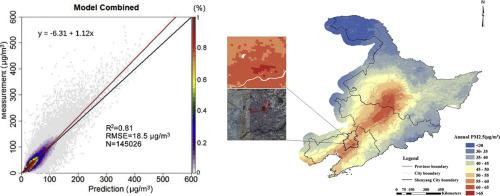当前位置:
X-MOL 学术
›
Remote Sens. Environ.
›
论文详情
Our official English website, www.x-mol.net, welcomes your feedback! (Note: you will need to create a separate account there.)
Estimating PM2.5 concentrations in Northeastern China with full spatiotemporal coverage, 2005–2016
Remote Sensing of Environment ( IF 13.5 ) Pub Date : 2021-02-01 , DOI: 10.1016/j.rse.2020.112203 Xia Meng 1 , Cong Liu 1 , Lina Zhang 1 , Weidong Wang 1 , Jennifer Stowell 2 , Haidong Kan 1, 3 , Yang Liu 4
Remote Sensing of Environment ( IF 13.5 ) Pub Date : 2021-02-01 , DOI: 10.1016/j.rse.2020.112203 Xia Meng 1 , Cong Liu 1 , Lina Zhang 1 , Weidong Wang 1 , Jennifer Stowell 2 , Haidong Kan 1, 3 , Yang Liu 4
Affiliation

|
Abstract Predicting long-term spatiotemporal characteristics of fine particulate matter (PM2.5) is important in China to understand historical levels of PM2.5, to support health effects research of both long-term and short-term exposures to PM2.5, and to evaluate the efficacy of air pollution control policies. Satellite-retrieved aerosol optical depth (AOD) provides a unique opportunity to characterize the long-term trends of ground-level PM2.5 at high spatial resolution. However, the missing rate of AOD in Northeastern China (NEC) is very high, especially in winter, and challenges the accuracy of long-term predictions of PM2.5 if left unresolved. Using random forest algorithms, this study developed a gap-filling approach combing satellite AOD, meteorological data, land use parameters, population and visibility in the NEC during 2005–2016. The model, including all predictors, combined with a model without AOD was able to fill the gap of PM2.5 predictions caused by missing AOD at 1-km resolution. The R2 (RMSE) of the full-coverage predictions was 0.81 (18.5 μg/m3) at the daily level. Gap-filled PM2.5 predictions on days with missing AOD reduced the relative prediction error from 28% to 2.5% in winter. The leave-one-year-out-cross-validation R2 (RMSE) of the full-coverage predictions was 0.65 (16.3 μg/m3) at the monthly level, indicating relatively high accuracy of predicted historical PM2.5 concentrations. Our results suggested that AOD helped increase the reliability of historical PM2.5 prediction when ground PM2.5 measurements were unavailable, even though predictions from the AOD model only accounted for approximate 37% of the whole dataset. Predicted PM2.5 level in NEC have increased since 2005, reached its peak during 2013–2015, then saw a major decline in 2016. Our high-resolution predictions also showed a south to north gradient and many pollution hot spots in the city clusters surrounding provincial capitals, as well as within large cities. Overall, by combining predictions from the AOD model with higher accuracy and predictions from the non-AOD model to achieve full coverage, our modeling approach could produce long-term, full-coverage historical PM2.5 levels in high-latitude areas in China, despite the widespread and persistent AOD missingness.
更新日期:2021-02-01


























 京公网安备 11010802027423号
京公网安备 11010802027423号